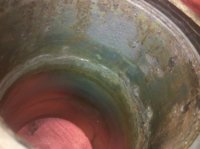sgallaty
Antihero
I bought a siezed engine from a friend that ended up having a great deal of rust in one cylinder and a ring in the other.
I'd read different derusting methods and there was only one that appealed to me which was phosphoric acid rust removal.
The method is to create phosphoric acid with a 9:1 ratio of molasses to water, and then submerge the piece in the solution.
It is also available in larger concentrations commercially. http://www.42gpw.com/acid.html
--
Experiment -
The experimental piece is a set of cylinders which significant rust on one cylinder and light surface rust on both.
Method -
Submersion in a solution of 9parts water to 1 part molasses, combined with nonabrasive physical debris removal and solution agitation.
Chronological Diary
Started experiment on 7/12. Created solution and immersed head.
Observations :
even after rinsing, the head had a great deal of foreign material and oils adhering to it. This caused pollution of the solution.
solution did not begin to react for approx 12 hours after immersion. did not test, but suspect that the phosphoric acid is not formed immediately.
It has a moderately unpleasant odor
Notes :
For the next experiment, we'll soda blast to thoroughly clean all parts prior to immersion.
for best results, solution should be premixed 24 hours prior to immersion.
when process is underway, bubbles (presumably oxygen from the FeO Iron Oxide breaking down and the formation of FeP2/FeP3 Ferrous Phosphate.
Condition of piece on 7/12
I'd read different derusting methods and there was only one that appealed to me which was phosphoric acid rust removal.
The method is to create phosphoric acid with a 9:1 ratio of molasses to water, and then submerge the piece in the solution.
It is also available in larger concentrations commercially. http://www.42gpw.com/acid.html
--
Experiment -
The experimental piece is a set of cylinders which significant rust on one cylinder and light surface rust on both.
Method -
Submersion in a solution of 9parts water to 1 part molasses, combined with nonabrasive physical debris removal and solution agitation.
Chronological Diary
Started experiment on 7/12. Created solution and immersed head.
Observations :
even after rinsing, the head had a great deal of foreign material and oils adhering to it. This caused pollution of the solution.
solution did not begin to react for approx 12 hours after immersion. did not test, but suspect that the phosphoric acid is not formed immediately.
It has a moderately unpleasant odor
Notes :
For the next experiment, we'll soda blast to thoroughly clean all parts prior to immersion.
for best results, solution should be premixed 24 hours prior to immersion.
when process is underway, bubbles (presumably oxygen from the FeO Iron Oxide breaking down and the formation of FeP2/FeP3 Ferrous Phosphate.
Condition of piece on 7/12


